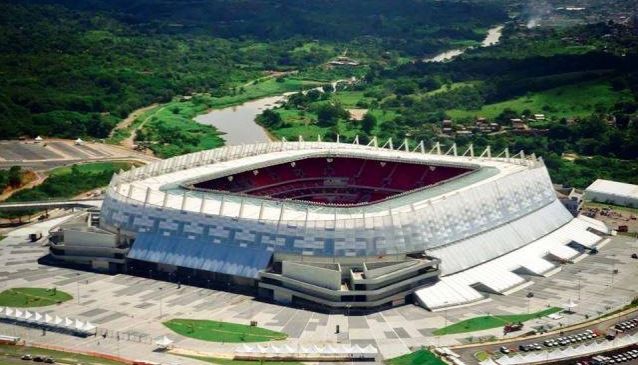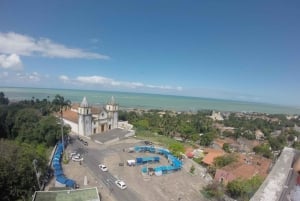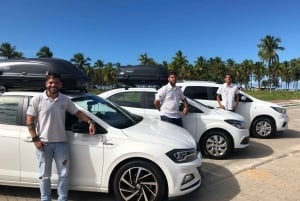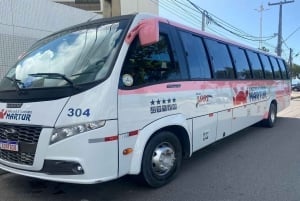The Fifa World Cup returns to Recife
After 64 years, Recife returns to host the biggest sport event on the planet: the Fifa World Cup.
Book Top Experiences and Tours in Recife:
If youʻre booking your trip to Recife last minute, we have you covered. Below are some of the top tours and experiences!- Olinda City Tour and Instituto Ricardo Brennand
- Recife: Airport to Porto de Galinhas Transfer
- Porto de Galinhas and Recife Private Transfer
- Recife: Tour to Carneiros with Catamaran Ride
- Instituto Ricardo Brennand with transfers from Recife
The capital of Pernambuco already has hosted a World Cup match, in 1950 at the stadium Ilha do Retiro, in a memorable game when Chile beat the United States 5-2.
This time, the city will host five World Cup games at the Arena Pernambuco, a new state-of-the-art stadium built in Sao Lourenco da Mata in Recife’s metropolitan region, just 19 km away from Guararapes International Airport.

A new stadium
Pernambuco is one of the most traditional States of the Brazilian football championships. Recife is home to three historic Brazilian clubs; Nautico, Santa Cruz and Sport. Each team have their own private stadium - Aflitos, Ilha do Retiro, and Arruda respectively - but the state government of Pernambuco, in partnership with a private consortium, have decided to construct a new, ultra-modern one up to the exacting standards of the FIFA World Cup: the Arena Pernambuco has been built in the metropolitan area surrounding Recife with easy access by public and private transport.

A mascot that loves the environment
The Tatu bola, or three-banded armadillo, is the official mascot for the 2014 World Cup. This animal, which is in danger of extinction, has three distinctive bands on its shell and is found in northeast Brazil. If you want to see a real one you can visit the Dois Irmaos ('Two brothers') Zoo, on the outskirts of Recife city.
The armadillo rolls up into the shape of a ball when threatened. The mascot carries the colours of the Brazilian flag - the armadillo is yellow, with green shorts and a blue shell and tail. It is dressed in a white shirt with the words "Brazil 2014'' written on it.
Fuleco, the mascot's adopted name, comes from the Portuguese words "futebol'' (football) and "ecologia'' (ecology), and FIFA said it "seamlessly represents the way in which the FIFA World Cup can combine the two to encourage people to behave in an environmentally friendly way".
FIFA marketing director Thierry Weil says: "Not only is he well known and recognised by the vast majority of Brazilians, he also seems to have built up a rapport with soccer fans and is a popular figure, even gaining his own affectionate nickname 'tatu-bola'. He is fast becoming the most successful FIFA World Cup mascot of all time."
Each mascot has been unique and focused on different issues relevant to their time, so now we look forward to seeing more of Fuleco, who describes himself as: "A proud Brazilian, warm-hearted and hospitable, like so many people in my country."
Previous World Cup Animal mascots
World Cup Willie (1966, England) The first mascot used at a FIFA tournament was in 1966 in England when World Cup Willie was created. He was a cartoon lion wearing a Union Flag jersey chosen to symbolise the host nation's history and tradition.
Striker, the World Cup pup (1994, USA) The United States went back to the idea of having an animal as the mascot for their first-ever World Cup, creating Striker, a dog that, similar to its name, played upfront. Wearing the US’ red, white and blue, Striker was designed by the Warner Brothers animation studios, and had USA '94 written on its shirt.
Footix (1998, France) A rooster, one of France’s national symbols, was chosen as the mascot of the 1998 World Cup, with Footix, as it was called, having a blue body much like France’s kit, a yellow beak and red feathers. The name Footix was chosen after 47 percent of the 18,500 respondents to a vote chose it over the likes of Zimbo, Houpi, Raffy and Gallik.
Goleo and Pille (2006, Germany) The second lion mascot to be made for the Fifa World Cup, Goleo wore a Germany shirt with the number ’06′ on its back, and carried around a football which was called Pille. The name Goleo came from the words ‘goal’and ‘leo’, the latter being Latin for ‘lion’.
Zakumi (2010, South Africa) The 2010 World Cup in South Africa saw the creation of a leopard as its mascot, with Zakumi owning a green mane and wearing a shirt that said ‘South Africa 2010′. Its green and golden colours represented the colours of South Africa’s national sports teams, while its name came from Za (for South Africa) and Kumi (which means ‘ten’ in African languages, the year in which the World Cup was being held).

Recife’s Host City poster
The official poster represents the essence of a coastal host city full of multicultural, art and entertainment. With colourful umbrellas, dancers perform an elaborate choreography that seems to fill the world with delight.














